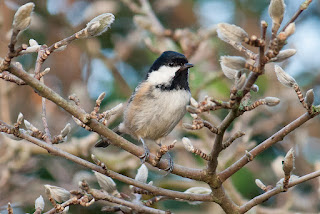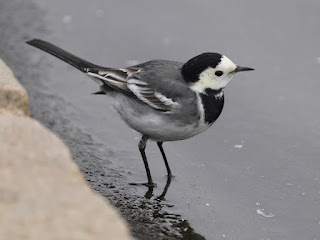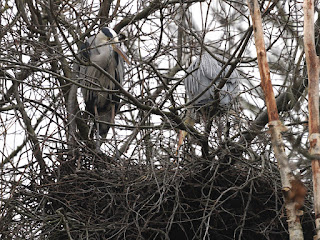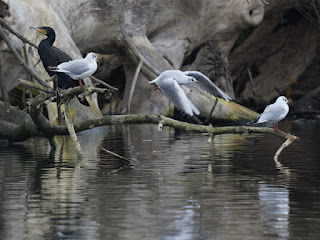After spending some time on the Royal Lancaster Hotel, the Peregrines have gone back to their old station on the Knightsbridge Barracks. I would have thought that the hotel was a better winter place as they can shelter behind the ornamental screen at the top of the building, but Peregrines have their own way of doing things.
A Great Spotted Woodpecker took off from a tree beside the Long Water. There was a pair here chasing each other flirtatiously.
In the colder weather many more tits are coming out to be fed. This Great Tit was in a bush near the bridge.
Another fine picture by Neil, of a Coal Tit among the woolly buds of a Star Magnolia.
A small flock of Starlings feeding under a tree ...
... suddenly all took off together for no visible reason.
A Pied Wagtail hunted at the Lido.
There were two Grey Herons on one nest on the island, and one on the other nest.
A young Herring Gull dived in shallow water to bring up a leaf or a stone or anything interesting to play with.
They also dive to get crayfish, but the crayfish population of the lake has had one of its periodic crashes and there are almost none to be had.
An adult Black-Headed Gull played with a twig. Adult gulls still play with things, but less often than young ones.
A Cormorant and Black-Headed Gulls perched on the fallen poplar at the Vista.
Fallen trees are left in the lake because health and safety regulations mean that an enormous and expensive operation has to be launched to remove them. This is for the best, as the trees provide perches and drinking places or all kinds of birds.
A Mute Swan chewed bark off the twigs of a waterside shrub. I've seen geese eating bark, but never a swan till now.
The recently formed swan pair in the Italian Garden seem to be happy with each other and with their home in the fountain pools. I wonder if they will try to nest in a corner of the garden, which is unlikely to succeed because the area is thick with foxes. They can't nest on the Long Water because the dominant swan would attack them.
A Gadwall under a fountain didn't seem to mind being pelted with bucketfuls of water, and placidly carried on eating algae.
A Greylag Goose played with a plane leaf but made no attempt to eat it. Plane leaves are waxy and tough, and not at all appetising.
A pair of Egyptians are constantly displaying on the sawn-off poplar at Peter Pan. The tree is useless as a nesting place but provides a platform for establishing territory with loud displays before they nest quietly in a hole in a nearby tree.
Joan Chatterley sent this pleasing photograph of Mandarins in Battersea Park. We are seeing fewer and fewer Mandarins here. They seem to have given up any idea of breeding, as the many hungry gulls are bound to pick off their ducklings.














That's a very sad thought, to think that they have given up on having more ducklings. There are far too many gulls with no natural predator.
ReplyDeleteIt's odd how cold and undemonstrative the Peregrine couple are to one another. It'as as if they were actively ignoring each other,
Yes, Peregrines are definitely not cuddly birds. But they stay as a pair and call to each other. I think all hunting birds need a large space around themselves simply to avoid colliding with each other when they see prey. You see this even with little birds such as wagtails.
DeleteGood to see the Peregrines socially distanced! I've noticed they rarely get too close to each other from my experiences of them on Ealing Hospital. It's amazing they ever get intimate!
ReplyDeleteDespite Tinuviel's suggestion there are too many gulls all our large species are amber listed as they are in national decline, though this may mask some local increases such as some city populations. If Goshawks ever become urban birds over here like they are in parts of Germany they will have a natural enemy, though Peregrines occasionally take them.
Lovely shot of the Mandarins. Though they may not successfully breed there, overall their population is going up.
Herring Gull numbers are increasing steadily in the park, and a large proportion of them are in their first few years. This is due to the expansion in the breeding colony in Paddington, which I think was released from its original cramped quarters between the glass roofs of the railway station and are now on the wide expanse of the flat roof of an office building. I think that Lesser Black-Backs have started to breed nearby too, judging by the rising number of young birds.
Delete